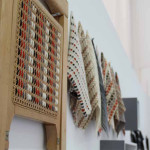Stephanie Rolph was asked to select her 5 favourite weave designers at New Designers 2013. Stephanie recently graduated from Central Saint Martins, BA (Hons) Textile Design and is about to commence an MA in Woven Textiles at The Royal College of Art
Aston Bradley
www.astonbradley.wordpress.com/
Aston’s collection, ‘Aqua Abyss’, was inspired by the reactive qualities of jellyfish, coral reefs and sea anemones. A refreshing take on sea-inspired projects, her work focused on creating fabrics that reacted to changing environments. Combing natural and synthetic reactive yarns in particular structures she was able to create a strong collection of weaves with a beautiful depth and movement created by the shrinking and stiffening of yarns.
Images: Aston Bradley
Anna Piper
An MA Design Innovation student at Nottingham Trent (completion Oct 2013), Anna’s collection focused on the process of woven textiles design and production for fashion. Her work is visually striking with strong geometric forms and a monochromatic colour scheme accented with a vivid red. Her work strives to create “single component garments†and through her research into doing this she has created a striking collection of technical fabrics that form a cross over between technical sports fabrics and woven heritage pieces. www.annapiper.net/#
Images: Anna Piper
 Emma Dawson
www.emmaclaredawson.wix.com/emmaclaredawson
In a sea of pattern and colour at New Designers Emma’s work stood out for the use of negative space and neutrals within her collection. Brilliantly intricate jacquards, inspired by an African and Mexican clash of cultures, were compliment by more simple, yet stunning, dobby weaves. The balance of brights and neutrals showed a sophistication of design and allowed each piece enough room to sit in the collection.
Images: Emma Dawson
Amelia Warner
www.amelie-amelie.tumblr.com/
Lurex was a popular yarn choice amongst weave graduates showing at New Designers this year yet few used it as well as Amelia. Her double cloth jacquards combined silk and lurex in such a way the fabrics looked almost foiled or flocked. This effect was complimented by her stunning colour palette and bold geometric shapes.
images Amelia Warner
Kim Norrie
www.kimnorrie.co.uk/index.htm
Kim’s approach to generating woven textiles is completely unique and intriguing. Alongside tradition dobby samples Kim showcased her ‘meshed’ weaves. Up-cycling materials such as netting and airtex Kim used heat pressing to generate new meshes which she used as a base to weave into. Meshes were also produced on-loom and then worked back into once they had undergone finishing techniques. Her innovative process created a beautiful collection that challenged the idea of woven fabrics.
Further sites: www.designinaction.com/news/award-prize-commercial-potential/
www.newdesigners.com/page.cfm/link=378
blog.artsthread.com/2013/06/designers-associate-prizes-2013/?utm_source=twitterfeed&utm_medium=twitter&utm_campaign=designers-associate-prizes-2013
images: Kim Norrie
Stephanie Rolph: (im)Permanence
“It is our perception of space that alters the space.
It is consciousness that finds meaning in all spaces.â€
This Bryan Lawson quote was the starting point of Stephanie Rolph’s project. Initially shewas interested in how uses of spaces can help define them. As her project progressed she became enthralled by the social lives of spaces. How does human interaction influence the meaning of a space? How does an inert space come alive to portray meaning? This research translated into an investigation of modular furniture, and discovering new ways to make rigid, self supporting weaves. Through extensive material experimentation she developed a process involving weaving, heat setting and laser cutting to form a modular furniture system. The pieces can be arranged in various ways to create a range of pieces: tables, benches, chairs etc. The owner is given the opportunity to express themselves and in turn define the space the pieces inhabit. This project was about challenging how we can define a space. Her furniture system offers the chance, through active participation in design, for everyone to add personal meaning to spaces.
Images: Stephanie Ralph













Leave a Reply